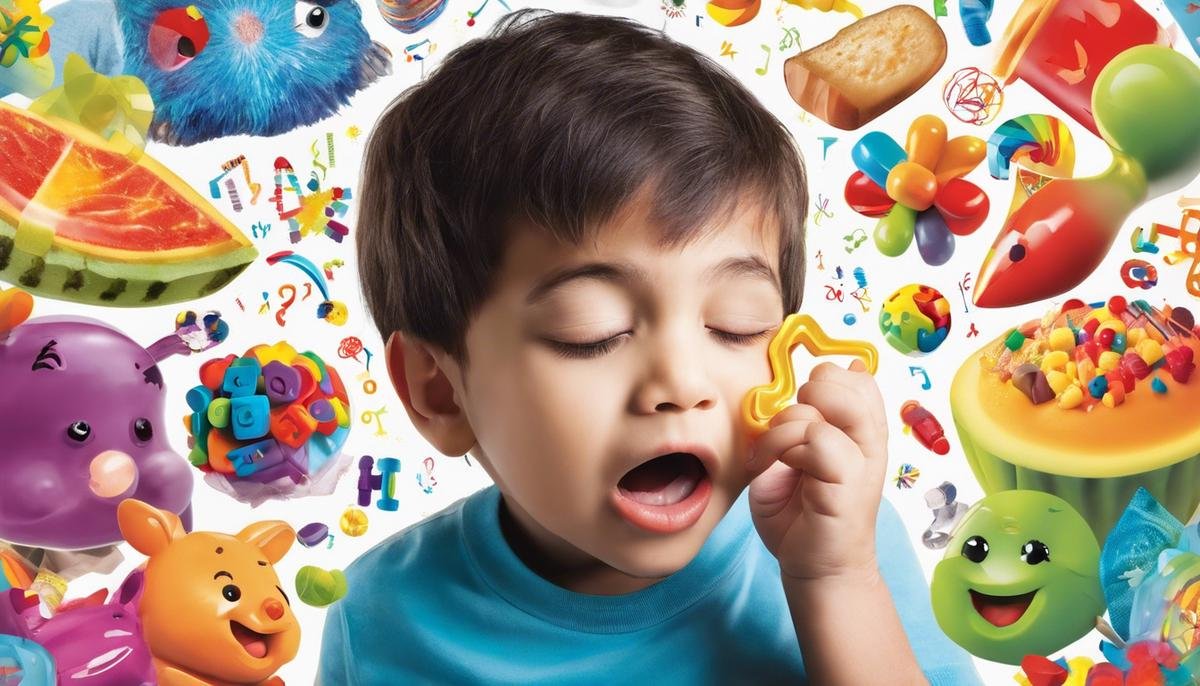
Autism is a complex developmental disorder that manifests various behavioral challenges among sufferers, one such behavior is biting. This concern, prevalent in autistic children, may stem from a myriad of reasons, whether as a reaction to sensory overload, communication difficulties, or a quest for distinct sensory input. Blogging is undoubtedly imperative to comprehend what is provoking this behavior before exploring possible solutions. Solutions can be multimodal and include effective communication strategies, such as the use of visual aids, social stories, or essential sign language, to allow expression without recourse to biting. Furthermore, we can consider sensory substitutions and distractions, such as oral motor tools or fidget toys, as a strategy to channel the biting action toward more acceptable sources.
Understanding the Cause
Understanding What Triggers Autistic Children to Resort to Biting
Raising children is an adventure full of joys, challenges, and learning opportunities. Now, let’s delve into a taste of the reality of parenting – specifically, tackling the issue of biting among autistic kids.
Autistic children, like any other, are unique and wonderful individuals. However, they may often express themselves differently, and one behavior that baffles many parents is biting. Yes, biting can be concerning, but understanding what triggers it could go a long way in devising helpful coping strategies.
Autism often comes with sensory challenges. Many autistic individuals experience the world more intensely through their senses than others. This could mean being extra sensitive to textures, sounds, or tastes – an experience called sensory overload. In some cases, biting is a response to this overload. It’s a way for these kids to manage the overwhelm — a release or escape mechanism.
Importantly, an autistic child might resort to biting as a means of communication. Children with autism sometimes have difficulty expressing their needs, wants, and feelings verbally. Therefore, biting might be a response to frustration over not being able to communicate their thoughts and emotions effectively.
The fact that biting often obtains immediate attention can also play a role. Whether it’s positive or negative attention, this behavior can be a way for them to assert control over their environment and interactions – a world they often find difficult to navigate.
Just like all children, autistic kids also feel various forms of stress and anxiety. These feelings can be triggered by numerous factors such as unfamiliar surroundings, unexpected changes in routine, or social pressures. And biting could be an outlet or coping mechanism for these anxieties.
Kids with autism might also bite due to physical causes. Dental issues, allergies, or other health problems can cause discomfort that children can’t express in typical ways. Biting, in these instances, becomes an exacerbated response to physical discomfort.
The key to reducing this behavior effectively, however, is understanding each child’s specific triggers and working out preventative measures or alternate coping mechanisms. In coordination with occupational therapists and autism specialists, parents can formulate personalized strategies to handle these scenarios positively and productively.
Remember, biting is not a behavior exclusive to children with autism. However, understanding the context for our little ones with autism allows us to offer them love, frustration-free communication, stability, and appropriate stress-management tools tailored to their needs.
In this journey of parenting, let’s continue to create an atmosphere of empathy, understanding, and acceptance for all children, including those with autism. Because when we strive to understand our differently-abled children better, we bridge gaps, shatter misconceptions, and, most importantly, create a harmonious environment where everyone thrives. Let’s always step inside their shoes, hear their voices, and see their world from their eyes. It’s how we, as kind and caring parents, can make a difference.

Effective Communication Strategies
Cultivating Effective Communication to Address Biting in Autistic Children
Home – it’s where the heart is, building bonds, fostering love, and supporting each family member’s growth. As a parent, watching our children struggle or face challenges can be heartbreaking. Nowhere is this truer than when addressing autistic children’s behavioral issues, such as biting. But, fear not dear parents; these difficult patterns can be mitigated with effective communication strategies.
Statistics suggest that behavioral issues like biting are more prevalent among autistic children due to reasons already discussed. However, it’s crucial to remember, especially for those new to this journey, that biting is not a purposeful act of aggression. Acknowledging this fact is your first step in promoting sympathy, understanding, and compassion. It can also push you to dig deeper for solutions instead of merely reacting to the action.
Cracking the code of non-verbal communication can often be the game-changer parents need. Autistic children sometimes use biting as a form of interaction when they’re unable to express through words. Noticing subtle cues can pave the path towards healthier communication, reducing the biting incidents.
For instance, changes in their body language, facial expressions, or demeanor can hint if they’re feeling overwhelmed or anxious. One solution might be to establish a ‘safe signal,’ a unique symbol that your child can use when they are not feeling well or needing space. This simple tool empowers them with a voice, helping to dissolve frustrations that might otherwise manifest as biting.
Consistency plays a crucial role in this communication strategy. Parents and other family members should react similarly to the ‘safe signal,’ creating a predictable response that will comfort the child. So, consider discussing and setting down agreed responses within your family and with any caregivers involved.
Positive reinforcement is another effective method. Reward or praise your child for communicating without resorting to biting and express your pleasure in words they can understand. This not only fosters better communication but can also boost their self-confidence.
Furthermore, visual aids like picture cards or charts can be productive tools, especially for children who respond better to images than to verbal instructions. These aids can help them express a broad range of emotions, needs, and wants, mitigating their urge to bite.
Lastly, don’t shy away from employing professional help. Therapists with special training in communication strategies for autistic children or autism spectrum disorders can be a godsend, providing specialist advice and guidelines based on your child’s specific needs. However, remember, as paramount as professional advice is, it should complement and not replace your intuitive understanding, warmth, and unwavering love for your child.
It’s never a one-size-fits-all solution, dear reader. With patience, persistence, and consistent effort, the day isn’t far when you’ll help your child conquer this hurdle and steer them towards more effective communication. Remember, you’re not alone in this journey, and your efforts resonate even when progress appears to be slow. Stick with it, battle through this phase, and remember, every child deserves abundant love and understanding – yours is no exception.

Sensory Alternatives and Distractions
Delving into Sensory Alternatives to Divert Biting in Autistic Children
Managing an autistic child’s biting behavior could be quite challenging for parents. Acknowledging why a child may resort to biting is an enlightening beginning. With a few sensory alternatives, it becomes achievable to divert this behavior. Here are different sensory alternatives that could help detour an autistic child from biting.
Oral Sensory Chews
Providing an autistic child with an oral sensory chew can serve as a superb alternative to biting. These discrete tools come in various shapes, textures, and hardness levels catering to all children’s different sensory needs. The act of chewing on these items can calm a child and provide a legal outlet for expressing the need to bite.
Weighted Blankets
Weighted blankets are another excellent sensory tool for children with autism. The gentle pressure they provide mimics a hug, helping children feel safer, relaxing them, and reducing anxiety-induced biting.
Sensory Play
Engaging children in activities that provide varied sensory experiences could divert their attention from biting. Physical play that involves touch, like squishing play dough, molding clay, or running their hands through kinetic sand can provide a calming effect.
Visual Timers
Some children may bite due to an inability to understand the concept of time, causing frustration or anxiety. Visual timers show time elapsing, providing the child with a concrete understanding that every activity has a beginning and an end. This method can help reduce biting outbursts.
Calming Spaces
Create a designated area for the child to retreat when feeling overwhelmed. This place could have a mix of comforting items such as stuffed animals, soft blankets, calming wall color, soothing sounds like nature sounds, or aromatherapy diffusers.
Noise Cancelling Headphones
If sensitivity to noise leads to biting episodes, investing in a good pair of noise-canceling headphones can provide a respite, helping your child regain balance and control.
Vibration Toys And Therapy
Vibration can be an excellent sensory alternative for children with autism. Some vibrating toys offer calming sensory input, and vibration therapy can help desensitize a child’s mouth to reduce biting.
Fidget Toys
Fidget toys can help an autistic child focus, self-regulate, and reduce frustration and anxiety-induced biting. They come in an array of shapes, sizes, and textures, providing endless options to keep your child occupied.
Additionally, remember that the steps used to divert the biting behavior should be implemented patiently and at the child’s pace. The transition to new sensory alternatives should be gradual and not forced. Every child is unique so one may respond to these alternatives differently than another, don’t lose hope if different approaches have to be tried until the right one is found.
Remember, parents are not alone on this journey. There is an abundance of resources and communities available online, full of advice, empathy, and understanding. Supporting a child with autism might be taxing at times, but those precious moments of progress make everything worth the effort.

Undeniably, dealing with biting behavior in autistic children may not be a walk in the park. However, deploying a range of strategies can help both the child and those around them attain some level of comfort. Key among these are understanding the underlying causes of the behavior, establishing effective channels of communication tailored to the child’s needs and capacities, and providing suitable sensory alternatives to deter the biting habit. It takes forethought, patience, and often trial-and-error to find what works best, but the results can significantly improve the quality of life for the child and their caregivers or educators.




